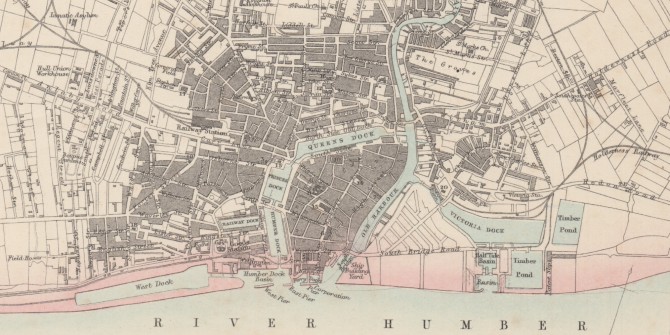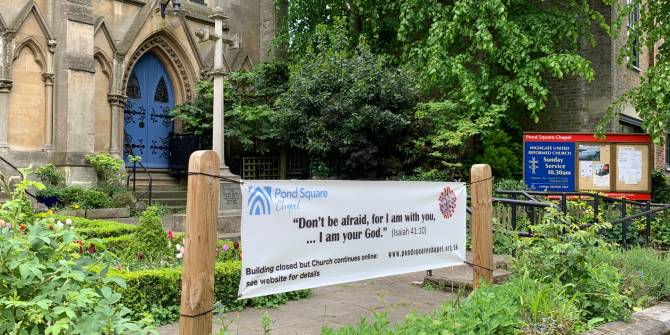Discussing the potential effects of the COVID-19 lockdown on housing, Paul Cheshire and Christian Hilber write that real house prices and rents may fall in the short- to medium-term. Yet housing will remain unaffordable for the young and those on lower incomes, especially in London and the South East, as this fall will be driven by a fall in earnings.
To speculate usefully about the effects of the COVID-19 pandemic on Britain’s housing market one needs a clear analytical understanding of how our housing markets work and what forces cause them to change. Given the extreme uncertainty about the impact and evolution of the COVID-19 pandemic, anything in this blog is in some sense speculation, but we hope informed speculation. A recent academic paper analysing the impacts on house prices and rents of historic epidemics in Amsterdam and Paris found only relatively short-lived and localised reductions in house prices and smaller effects on rents than on prices. While useful, we are cautious about trying to draw direct lessons from such historic examples: not least because the extent of lockdown and economic disruption now is an order of magnitude greater. COVID-19 is a true pandemic, affecting the whole interdependent world economy at the same time.

Apart from applying basic analytical tools it is also probably useful to look at the impacts in terms of three time horizons: the short term – over the next 6 to 9 months; the medium term -up to about 2024; and the long term – over the next 10+ years. The further ahead one looks the more uncertainty attaches to one’s predictions, but we will do our best.
Britons have become conditioned to expect rising house prices in real terms. After all, they have increased fivefold since the 1950s, faster than in any other OECD country. This rise has been driven mainly by rising real incomes – over that period they increased threefold – and an increasingly fixed supply of housing in large parts of the country. The supply of new houses is so inflexible because our planning system is dysfunctional and our system of local government finance provides no incentives for local authorities to permit development (see here, here or here). It is rising real incomes that fuel the demand for ‘housing services’ (reflected in rents) but part of what fuels the demand for housing as an asset is rising house prices relative to the price of other assets. And this, in turn, given the nearly fixed supply of houses, may fuel further price rises.
So this is the first pointer to what the COVID-19 crisis will do to the British housing market. In the very short term, it will produce stasis: buying and selling will all but stop. Indeed, they already have – Zoopla reports a 40% drop in enquiries for late March. Even when the lockdown is over and the market ‘unfreezes’, the transaction volume is likely to fall substantially. In part this will be because households are loss averse and not likely to want to realise a loss; but also because of the probable ongoing economic disruption discussed below.
While construction of new houses will be severely restricted, because new build homes are such a small fraction of the total stock, this will make little difference to total supply, so will do little to offset the fall in house prices. Moreover, the vast majority of COVID-19 deaths will be of elderly people, freeing up some existing stock and thus reinforcing, slightly, the temporary downward trend in house prices. Overall, the supply side effect of COVID-19 on house prices may be rather muted as the two effects (on construction and freed stock) may largely offset each other.
Thus, in the short term three things mainly matter:
- How far will lenders be willing – even be able – to flex to minimise the number of forced sales? Forced sales quickly translate into falling house prices as we saw in 1991;
- How catastrophically will borrowers’ incomes be hit and for how long?;
- How much and for how long will real incomes fall?
We are not medical experts so can offer no forecast as to how long the epidemic will last, nor the length of the severest disruption of normal economic activity resulting from it. We can offer two depressing thoughts, however: despite reassuring noises about renewed activity in China by the end of April, the Chinese, with far stronger controls and draconian powers of enforcement, started the lockdown in Wuhan on 23 January. In Britain, a far less effective lockdown started two months later. The Chinese began a gradual easing of their lockdown from 8 April. So maybe the UK lockdown will continue till early June, two months after the start of the easing in China. But even then the easing will be gradual and the resumption of normal economic activity will take probably months – assuming that there will be no further infection waves and depending on how quickly a vaccine can be developed and made available.
The second depressing thought is that the longer the lockdown lasts, the slower the recovery will be. The economy appears to be in freefall. Official data is hardly yet available but there was an ingenious review of current indicators in the Financial Times on 8 April: car sales down 44% in March; restaurant bookings on Open Table dropped to zero two days before the official lockdown. The OBR 14 April report was gloomy and emphasised that recovery from the initial near catastrophic hit was dependent on businesses being able to re-set. But it looks increasingly likely that many businesses will not survive: think of all those empty restaurants, bars or theatres; consider all those empty planes or hairdressers’ salons, think about how many small construction businesses, car dealers or gyms are at a standstill. The physical fabric will survive, but the government’s initiative to provide emergency finance seems plagued by delay and, while loans do not come, more and more businesses will go under. Recovery will be much slower if the businesses themselves have to be re-invented and established anew. Demand may be there and so may the workers but there have to be businesses to organise the process of production and employment.
Turning to the medium term, we first note that the longer the lockdown and the more businesses go under, the slower the bounce-back may be. The slower the economic bounce back, the slower the recovery in the demand for housing – driven by earnings – will be. And even when earnings start to recover, the savings of many will have been depleted. Would-be buyers will find much of what they had set aside for deposits will have gone on essential supplies to keep the household afloat while incomes were down. Buying a home will have to be postponed again even if prices appear to be more affordable. It took till 1945 for real house prices to get back to their 1931 levels: it took till late 2001 to get back to 1989 real values. House prices may have increased nearly fivefold since 1955 but there have been prolonged troughs along the way. We would not be surprised to find real house prices in 2024 well below present-day real values. The economic downturn triggered by COVID-19 may even equal that of the Great Depression of the 1930s. However, construction of social housing may have a bit of a revival. Lower house prices will not improve affordability in the medium term, however, since the cause would be lower incomes and depleted savings.
So what of the long term? To 2030 and beyond. Here we get even more speculative but we will assume that the pandemic dies away and the economy eventually recovers. The pandemic could even trigger an innovation boost e.g. in communication technology (which might damage the recovery of airlines and ground transport) or medicine. And, although we have long argued for radical reforms to those policies impeding building more houses where people want to live (such as releasing Green Belt land around commuter stations or reforming the tax system to incentivise local authorities to permit development), we will reluctantly assume there are none, at least no meaningful ones. One of the downsides of our expected prolonged depression in real house prices is that it may take the pressure off politicians to reform our dysfunctional housing supply.
If this is true, construction will stay well below the level needed to satisfy demand, so prices will take off when incomes finally recover. However, the structure of demand may change. Already there is talk of how we will not go back to what we were doing before COVID-19 struck. People may adjust to more home-working, including commuting to a central office but far less frequently. This would have two implications (apart from those it would have for the demand for office space): the first would be that people would demand more space in their houses; the second is that commuting costs might become less important. These would suggest a movement outwards to find cheaper land and space, and accept the longer commute that implied. In fact, before COVID-19 struck there was already evidence of people jumping the Green Belt so this would be a continuation of an existing trend.
Although not strictly following, a further related trend might be for higher-paid jobs to concentrate even more strongly in the first-order cities, notably London, Manchester, Edinburgh, even Leeds, at the expense of second-tier cities like Stoke-on-Trent, Derby or Coventry; and demand for housing to relatively increase in smaller but well-connected high-amenity cities like Cambridge, Canterbury, Exeter, Harrogate, Hexham or Norwich, further increasing house price pressures in these locations.
While there is huge uncertainty surrounding the COVID-19 crisis – not just its impact on the real economy, the financial markets, and the rate of recovery but also longer-term political consequences or the impact on globalisation – one thing is clear: COVID-19 is likely to have lasting effects on both Britain’s housing markets and housing policies. Real house prices (and rents) may fall in the short- and medium-term without making housing less unaffordable. It will remain particularly unaffordable for the young and those on lower incomes, especially in London and the South East, and for those hardest-hit by COVID-19. When it comes to housing policies, Britain’s policymakers (of all colours) would be well-advised not to jump on the populist bandwagon. There needs to be a policy reaction reflecting the true causes rather than the symptoms of the affordability crisis and the longer-term reforms that are the only way of truly resolving our housing problems. We need to learn from Germany, not just in terms of effective testing for COVID-19, but also from their housing and planning policies.
This post represents the views of the author and not those of the Covid-19 blog, nor LSE. It first appeared at the LSE British Politics and Policy blog. Featured image credit: by Adam Birkett on Unsplash.




